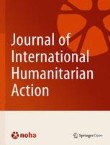The Journal of International Humanitarian Action is associated with the Network On Humanitarian Action (NOHA).
Gender dynamics in humanitarian leadership: navigating COVID-19 and beyond
This paper explores the intersection of the impacts of COVID-19 on women and girls in humanitarian settings with the necessity of incorporating female perspectives in decision-making roles within multilateral ...


